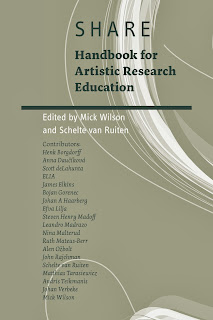The
SHARE network (Step-Change for Higher Arts Research Education)
announced its Handbook for Artistic Research Education. (Downloadable here.)
The
book can be of interest for some of the overview articles, e.g. in the contextualizing
first chapter “The Third Cycle in Arts Education: a contested construct”, or
the surveys in “Contested Values and Critical Debates”. But it is striking how James
Elkins’ partial view on the situation worldwide and his ‘Six Cultures of the
PhD’ typology do not resonate with the situation in the Low Countries, where,
at least when music is concerned, more than five different doctoral programmes
in artistic research enrich a single linguistic regional unity. The “New’ Doctoral Programmes: The Structured
PhD and the ‘New Pathway’ Doctoral Programme” chapter specifically seems to
relate only really to the visual arts.
It
is unfortunate that this emphasis on the visual arts, in both perspective and
focus, pervades the whole volume: except
for one case study (out of 11) – Paulo de Assis’ MusicExperiment21
project – there’s hardly anything in it for the musician.
And the case studies are illustrations rather than food for integrated
discussion, really. To be fair, the 39 partner institutions of SHARE don’t
distinguish themselves for being conservatories (even if some are of the larger
types, which encompass a music department), and the history of (doctoral)
research in the arts is indeed to a large extent to be traced in the fine arts. Still,
it remains hard – if possible – to just connect visual arts, design,
architecture, music, dance, etc. through research as a perceived common
denominator. I will be hard pressed to forget a meeting for the development of
the Artistic Research Catalogue, with a large majority of the work group being
visual artists, designers, etc., and room for only two musicians (a doctoral
student and myself). At some point, when the discussion on what to formally call
the presentation of artistic research outcome in the software centered on the
concept of ‘exhibiting’ art, my remark that I habitually reproduce someone
else’s art rather than create new art (I don’t improvise and I don’t compose),
with which I wanted to problematized the narrow view of an artist creating a
work that he owns (think of a painter, nowadays, striving to make a career by
trying as best he can to paint according to the intentions and skills of Van
Eyck), provoked the incredulous response by AR proponent and visual artist Florian
Dombois: “But why would you do that?”
If an understanding of each other’s
artistic identity is still to be developed at this level, we better not assume
to just equate research interests, methodology, types, goals, target audiences,
etc. Judging the content of the SHARE handbook, as well as many conferences on
AR (in fact, all those that I have known of), this gap is yet to be
acknowledged.

No comments:
Post a Comment